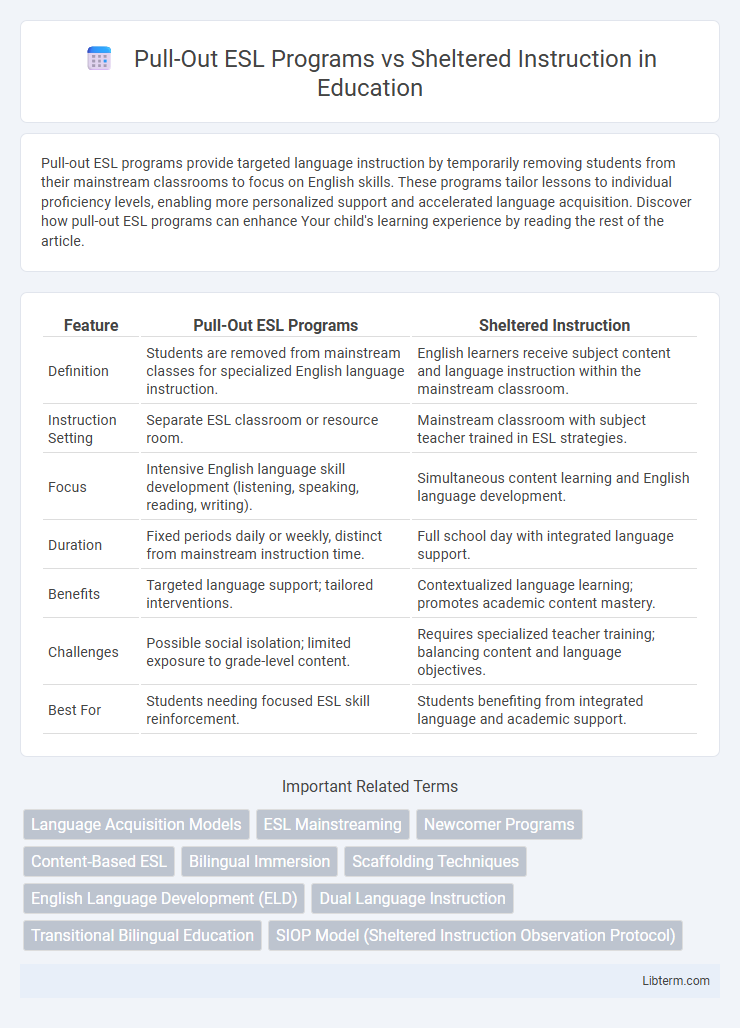Pull-out ESL programs provide targeted language instruction by temporarily removing students from their mainstream classrooms to focus on English skills. These programs tailor lessons to individual proficiency levels, enabling more personalized support and accelerated language acquisition. Discover how pull-out ESL programs can enhance Your child's learning experience by reading the rest of the article.
Table of Comparison
| Feature | Pull-Out ESL Programs | Sheltered Instruction |
|---|---|---|
| Definition | Students are removed from mainstream classes for specialized English language instruction. | English learners receive subject content and language instruction within the mainstream classroom. |
| Instruction Setting | Separate ESL classroom or resource room. | Mainstream classroom with subject teacher trained in ESL strategies. |
| Focus | Intensive English language skill development (listening, speaking, reading, writing). | Simultaneous content learning and English language development. |
| Duration | Fixed periods daily or weekly, distinct from mainstream instruction time. | Full school day with integrated language support. |
| Benefits | Targeted language support; tailored interventions. | Contextualized language learning; promotes academic content mastery. |
| Challenges | Possible social isolation; limited exposure to grade-level content. | Requires specialized teacher training; balancing content and language objectives. |
| Best For | Students needing focused ESL skill reinforcement. | Students benefiting from integrated language and academic support. |
Overview of Pull-Out ESL Programs
Pull-Out ESL Programs involve removing English language learners from mainstream classrooms for specialized instruction focused on developing English proficiency. These programs typically provide individualized or small group lessons targeting vocabulary, grammar, and conversational skills to enhance language acquisition. Pull-Out ESL allows for tailored support but may limit integration with grade-level content and peers during instruction time.
Understanding Sheltered Instruction
Sheltered instruction integrates language development with content learning by adapting lessons to English learners' linguistic needs while maintaining academic rigor. This approach emphasizes scaffolding strategies such as visual aids, modified speech, and interactive activities to promote comprehension across subjects. Understanding sheltered instruction is crucial for educators to effectively support English Language Learners (ELLs) in mainstream classrooms without segregating them from grade-level content.
Key Differences Between Pull-Out and Sheltered ESL
Pull-Out ESL programs separate English Language Learners (ELLs) from mainstream classrooms for specialized language instruction, typically focusing on vocabulary, grammar, and language basics in a small group setting. Sheltered Instruction integrates language and content learning within the mainstream classroom, using strategies like scaffolding and visual aids to make academic subjects comprehensible while promoting English proficiency. Key differences include the instructional setting, with Pull-Out ESL occurring outside the regular classroom and Sheltered Instruction embedded within it, and the focus, where Pull-Out emphasizes language skills exclusively, whereas Sheltered Instruction balances language development with content mastery.
Program Goals and Student Outcomes
Pull-Out ESL programs target individualized language development by removing students from mainstream classes for specialized instruction, aiming to improve English proficiency through focused language skills training. Sheltered Instruction integrates language support within content-area classes, promoting simultaneous development of academic content knowledge and English language skills to enhance both comprehension and participation. Students in Pull-Out programs often show targeted language gains, while those in Sheltered Instruction demonstrate improved academic achievement alongside language acquisition, supporting long-term educational success.
Teacher Roles and Qualifications
Pull-Out ESL programs require teachers specialized in language acquisition with certifications such as TESOL or CELTA to provide targeted language instruction outside the general classroom. Sheltered Instruction demands educators skilled in both content and language integration, often holding bilingual education credentials or training in Sheltered Instruction Observation Protocol (SIOP) strategies. Effective teacher roles in these programs hinge on expertise in cultural responsiveness, language scaffolding, and adapting instruction to meet diverse English learners' needs.
Integration With Mainstream Curriculum
Pull-Out ESL programs separate English learners from mainstream classrooms for targeted language instruction, which can limit direct exposure to grade-level content and slow content-area integration. Sheltered Instruction models embed language objectives within mainstream curriculum lessons, promoting simultaneous language development and academic achievement through differentiated instruction. Research shows sheltered instruction enhances student engagement with core subjects while supporting English proficiency growth in inclusive settings.
Student Engagement and Language Development
Pull-Out ESL programs provide focused language instruction by removing students from mainstream classrooms, which can limit real-time peer interaction but offer targeted skill development in vocabulary and grammar. Sheltered Instruction integrates language objectives within content lessons, promoting active student engagement through collaborative activities and contextualized language use that fosters both academic and conversational proficiency. Research indicates that sheltered instruction supports higher levels of student engagement and more natural language development compared to the isolated nature of pull-out sessions.
Challenges and Limitations of Each Approach
Pull-Out ESL programs often face challenges such as limited instructional time, which can hinder students' continuous language development and integration into mainstream classes. Sheltered instruction encounters limitations including the need for highly trained teachers skilled in both content and language pedagogy, which can strain school resources and affect program consistency. Both approaches may struggle with meeting diverse student proficiency levels while ensuring academic content mastery.
Best Practices for Program Implementation
Effective implementation of Pull-Out ESL programs requires scheduling that minimizes disruption to core classroom instruction while providing targeted language support by certified ESL teachers. Sheltered Instruction models thrive when content teachers receive comprehensive training in language acquisition strategies and collaboratively plan lessons integrating vocabulary development and language objectives. Both approaches benefit from ongoing progress monitoring, culturally responsive materials, and active family engagement to maximize English language learner outcomes.
Choosing the Right Model for Your School
Selecting the appropriate ESL program requires analyzing student needs, language proficiency levels, and available resources. Pull-Out ESL programs offer targeted language instruction outside mainstream classes, ideal for individualized support, while Sheltered Instruction integrates language learning within content area teaching, fostering simultaneous academic and linguistic development. Schools prioritizing holistic development and content mastery often find Sheltered Instruction more effective, though balancing staff training and class size remains essential for program success.
Pull-Out ESL Programs Infographic

 libterm.com
libterm.com